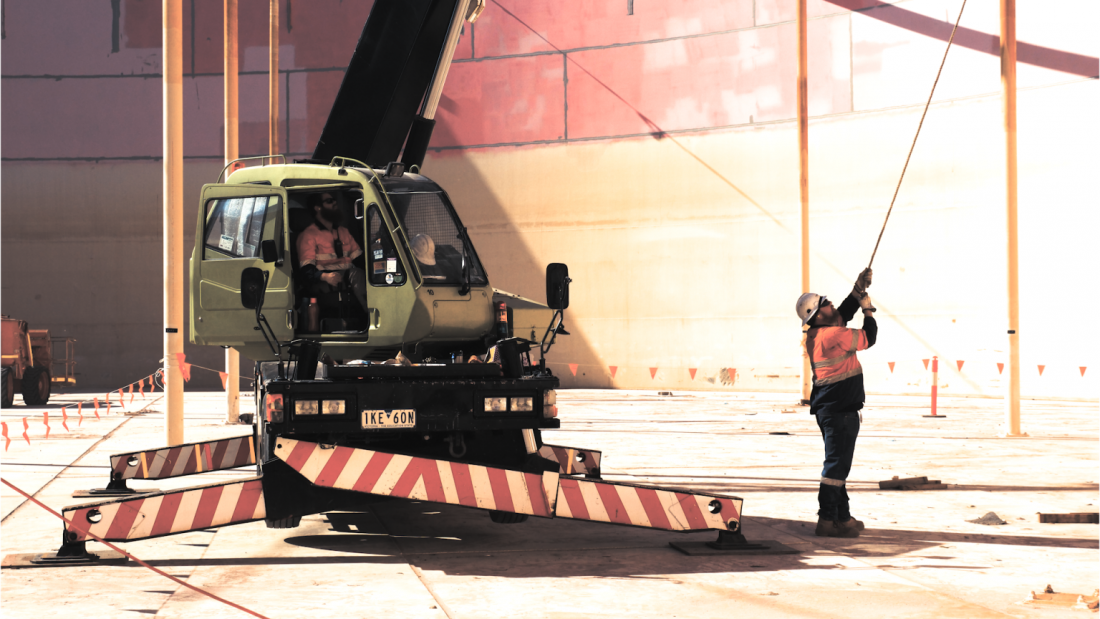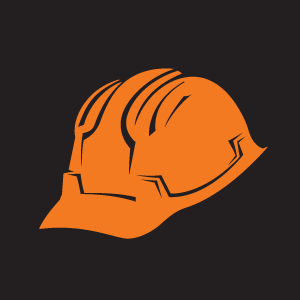Dogmen, Their Role and How To Become One
- magda

by Daniel Green
There’s an argument to be made that the ancient Iraqis and Kuwaitis were the world’s first lifting crews. Utilising pulleys as early as 1500 BCE, the Mesopotamians [as they were known] pioneered the power of circular rotation. Fast forward a millennia and a bit and Ancient Greek mathematician Archimedes [of Eureka bathtub fame] introduced compound pulleys, famously lifting an entire ship and its crew in 200 BCE. If Archie was on the whistle that historical day one could debate that he was the world’s first recorded dogger.
A dog is an old-timey name for a jaw-like mechanical lifting device used to grapple items. Kinda like the chops of your favourite hound around a dropped snag at a barbie. The term is unique to Australia as in the US they’re called spotters. In the UK they’re known as banksman.
What The Actual Heck Is A Dogman?
With mechanical dogs long sent to SIMS metal, a dogman’s prime job is to get the stuff from where it is to where it’s going via lifting. There’s far more to it of course. Overcoming gravity, momentum and weather will do that. In short, the dogman’s role is four fold:
- Sling the load using specialised, rated lifting equipment and appropriate techniques.
- Direct the crane operator to lift and place the load.
- Ensure the safety of people around the crane and live loads.
- Taking care of the lifting equipment including servicing and inspection.
The Good Gear
The modern crane is extremely versatile. So versatile that they’re often called on to lift all manner of shapes, sizes and weights with little notice. The safe movement of these sometimes awkward items calls for an array of lifting equipment:
- Chains
- Slings [light, strong, fibrous, woven loops of synthetic material]
- Ropes
- Spreader bars [steel bars designed to hold lifting chains apart to prevent crushing the load]
- Equaliser bars [steel bars used to equalise an unbalanced load]
- Dunnage [timber blocks that keeps cargo off the ground]
- Shackles
- Blocks [also known as pulleys]
- Swivels
- Chain mesh
As the caretaker and user of this equipment, Dogmen will also hold old maritime knowledge like the lay of ropes and cables, swaging, shackle types and uses, shoulder eye bolts and turnbuckles.
A Solid Techhie
Lifting bulky, unbalanced or extremely heavy items often needs the use of various methods of restraint. Some of these are simple, some complex, some call for a single piece of rigging or multiple pieces in unison, such as:
- Straight lifts
- Choking and double choking
- Baskets
- Bridle hitches
- Inverted basket with 2 leg bridle hitch
An experienced dogman will know which combination of equipment and technique will ensure the item will arrive safely and without damage.
Rigging, lifting and restraints may be as old as the Jerusalem hills but there’s science behind it. And just like old Archimedes, a dogman has to have a thorough understanding of maths. Some concepts they’re versed in:
- The SWL reduction of shoulder eye bolts corresponding to angle of pull.
- A choker hitch rated capacity in relation to the angle of choke.
- The quantity of saddle clips required for various wire rope diameters dependent on rope to turn back, including their required torque.
These and other detailed mathematical equations are taught during dogging training packages.
Bro, Do You Lift?
In a generic three man crew, the dogman rigs the load, the crane operator drives the crane and the rigger will unload/install the item. Because there’s so many factors, especially with bigger cranes and lifts, communication is absolutely vital. A series of hand signals developed of thousands of years has been formalised for lifting crews to be able to ‘talk’ quickly and easily when out of vocal range. Failing this the dogman can whistle or use a two-way.
I’m Lifting Here!
Lifting crews operate all hours of the day in all weather conditions and all levels of public scrutiny. Because they’re most often on the ground, it is the dogman’s role to delineate their work area from the general public as well as other construction trades.
A Lil TLC
The sheer forces applied to lifting equipment dictates the need for it to remain in good order. And as its primary handler it is the dogman’s responsibility to ensure it is safe and fully operational. Imagine a swivel hook not swivelling ten storeys up on a windy day. Or worse.
Government and industry standards dictate the strength and lifespan of lifting equipment. Some of these parameters are the frequency of inspection of equipment and by whom, damage or wear expressed as a percentage of original strength and Safe Working Loads [since replaced by Working Load Limit in 2002].
Depending on the size and type of operation, it is generally the dogman’s responsibility to ensure the equipment is checked, tested, maintained and destroyed/replaced if unserviceable.
Training Day
Actually its more like a full week. Going from a greenhorn to a fully fledged dogman is five full days of theoretical and practical training and assessment. Additionally, you’ll need to apply for a High Risk Work licence to formalise your training into the SafeWork system. Providing you don’t have any serious prior convictions or have had a HRW cancelled for nefarious activities, you should be fine. Considering dogging calls for lifting extremely heavy/awkward items from/to precarious positions in almost any scenario imaginable – a lot of training is a good thing.
Like all qualifications, this doesn’t mean you can now sling a 20t tilt-up panel with a single-choked double-bridled twin-swaged one inch left lay wire rope. Nope. Now your training really begins – with an experienced lifting crew at a crane company. Anyone can lift anything in yard conditions with the safety net of the trainer nearby. Out on site, with the pressure of observers, public safety, live powerlines, traffic control, summer heat, a broken sling – its a totally different ball game. But its a good one.
Becoming a dogman can be a very rewarding career move. There’s lots to see and do, lots to learn and if you’re lucky – a good crew to guide you.
There may even be a job at Perfect Hire.
Perfect. We Get It, Dawg.











